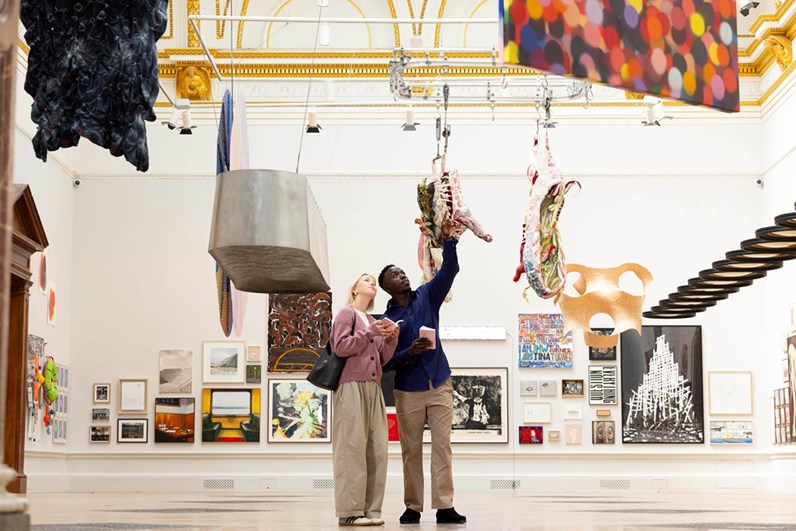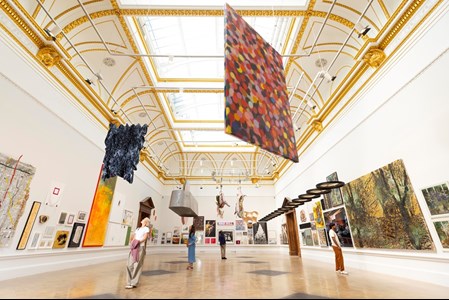J. M. W. TURNER painted a view of the Avon Gorge at Clifton in 1792. His 1851 obituary recorded that The Rising Squall, Hot Wells, from St Vincent’s Rock, Bristol was the first of his oils to be selected for the annual Royal Academy exhibition. As a precocious 15-year-old, Turner had already had a watercolour of The Archbishop’s Palace at Lambeth accepted in 1790, but getting an oil in at the age of 17 marked him out as a serious artist.
When it appeared there the following year, it was bought off the wall by a Kentish clergyman from Foots Cray, the Revd Robert Nixon (whose son went on to be Bishop of Tasmania and left the oil painting behind), but when it was last offered at a London saleroom, in July 1864, Christie’s failed to find a buyer.
It was sold last year, when it was thought to be only a work by a “follower of Julius Caesar Ibbetson”, as the painting appeared to be unsigned, at a provincial English saleroom in Newbury, for less than £500. Cleaning has revealed an early signature (“W. Turner”), and it has now been consigned to one of the London auction houses, with a modest estimate of £200,000-£300,000. It will be featured in Tate Britain’s forthcoming 250th-anniversary exhibition “Turner and Constable” (from 27 November to 12 April 2026).
Approaching this year’s Summer Exhibition, I had this saga very much in mind; what is a “lost” Turner worth? Dame Tracey Emin RA first showed in Piccadilly in the 1997 exhibition “Sensation”, a work that was entitled Everyone I have slept with 1963-1995. How much would that sell for now? Or in 2247?
In this year’s summer show, Professor Emin rather more powerfully shows the strength of her command of line (she is RA professor of drawing after all) in two moving and dramatic works: The Crucifixion 2025 is a large-scale painting in acrylic in a gallery room curated by Caragh Thuring (Room V), while the visitor first encounters her empathy and compassionate powers of observation, widely known from her autobiographical writings, in a monotype, You remained always beautiful, which is surrounded, in the octagon central hall, by six atmospheric etchings by the late Norman Ackroyd. Tory Island, Great Blasket, Roareim Flannan, Dingle, and Windermere are as densely inhabited as is the face of Emin’s sitter.
 Photo © Royal Academy of Arts, London/David ParryGallery view of the Summer Exhibition 2025, at the Royal Academy of Arts, London
Photo © Royal Academy of Arts, London/David ParryGallery view of the Summer Exhibition 2025, at the Royal Academy of Arts, London
This is not to suggest that the first room is in any deprecatory sense monochrome. Rather, the more than 100 works surrounding Alice Channer’s ostrich-feather and stainless-steel-chain sculpture (a pendant sculpture that is anything but a mobile) bring a range of textures and styles to redefine “black and white” with welcoming bravura: mezzotint; lithograph; drypoint; charcoal; ink; graphite; monotype; screenprint; photopolymer; gelatin silver; and giclée print. There are through views into the Lecture Room (the suggested route this year, which I did not follow; few did) and Gallery III.
Turning left into the Long Gallery, I found that natural lighting from the windows above accentuated the colourful aspect of the hang. There are big names here. Anselm Kiefer wrestles with Genesis 28, presenting the Sullam Ya‘aqob in his characteristic style which is such a strong trailer for the forthcoming show Kiefer/Van Gogh (28 June-26 October) that I wondered whether it was a leftover, completed too late to include; and Tony Bevan’s monumental head unwinds with red coils that appear like wire from a crown of thorns. But they never overpower other submissions.
Playfulness seems to be Farshid Moussavi’s hang for this room, with sculpted meat hooks and a chance for William Kentridge to reflect on his matutinal ritual in a lithograph, I look in a mirror I know what I need. It offers two “portraits” with Moka coffee-pot heads. Nor is he the only coffee-drinker. Alongside is Sir Michael Craig-Martin’s laser-etched red satin acrylic Quotidian Red: Moka Pot, and elsewhere Malcolm Doney, late of this parish, thinks it is Time for Coffee.
More than 1700 works constitute a large show, but it rarely seems overcrowded, although occasionally the cost of leaving large expanses of wall space empty is to put smaller works too high for the discreet number of the entry to be viewed from the floor. You could walk through the galleries and not see no. 661, Sir Quentin Blake’s Alone and Together 2, high on the inside wall of Gallery VI, which is a pity, as Alone and Together 3 is hidden on the back of the wall-divider of Room IX, which backs on to what used to be a gallery but is now an extended temple to the gods of marketing. I never found A and T 1 (no. 1386), and so will have to go back to find what is so enchanting about the nonagenarian’s ballpoint-scribbled portraits.
 Photo © Royal Academy of Arts, London/David ParryGallery view of the Summer Exhibition 2025, at the Royal Academy of Arts, London
Photo © Royal Academy of Arts, London/David ParryGallery view of the Summer Exhibition 2025, at the Royal Academy of Arts, London
There are political and satirical comments on our society, but they avoid hectoring the audience, unlike some misjudged museum signage. Barbara Walker, in two works from the series Marking the Moment, expropriates 17th-century portrayals of society figures with African pages. When Geoffrey Kneller painted Frederick, 1st Duke of Schomberg, who died at the Battle of the Boyne and is buried in St Patrick’s Cathedral, Dublin, there was rather more to say of him than this graphite on paper overlaid with Mylar hints. Dexter Dalwood, in two large pieces from another series, An Inadequate Painted History of Mexico, courtesy of Lisson Gallery, rather more subtly reminds us of The Execution of Emperor Maximilian and the fate of Manet’s depictions (1867-69).
Adam Dant’s biography of Turner and his rendering of London in the shape of a ginger cat, Capital City — A-Cat-Ographic view of London, raise a smile, as does Sir Grayson Perry’s Conversations with my fellow Academicians. Elsewhere, look out for the tightly composed and colourful works of Arinjoy Sen (nos. 744 and 745) which reference Mughal India, and Olwyn Bowey’s fastidious rustic vases of flowers (nos.1135 and 1136).
In the darkened misuse of the Small Weston Room, where Sir Isaac Julien draws on his 1989 film Looking for Langston for two impeccably turned-out suited and booted guys in tuxedos, you can watch Candice Breitz’s self-indulgent dual-channel video blog Factum Tremblay if you are waiting 78 minutes and eight seconds for your next appointment or are holding out for a date.
Stronger and more coherent than in the past ten years, this exhibition suggests that the RA has turned a corner, but where will the artists be in 30 years? What chance have even the Royal Academicians of commanding attention then? When Turner edged in, followed by his coeval John Constable, the landscape painter of choice among the Academicians of the day was Augustus Wall Callcott. Quite.
The 257th Summer Exhibition is at the Royal Academy of Arts, Burlington House, Piccadilly, London W1, until 17 August. Phone 020 7300 8000. www.royalacademy.org.uk

















